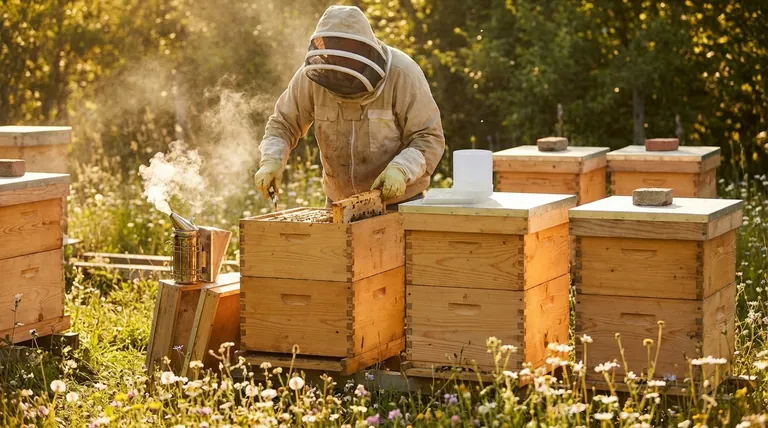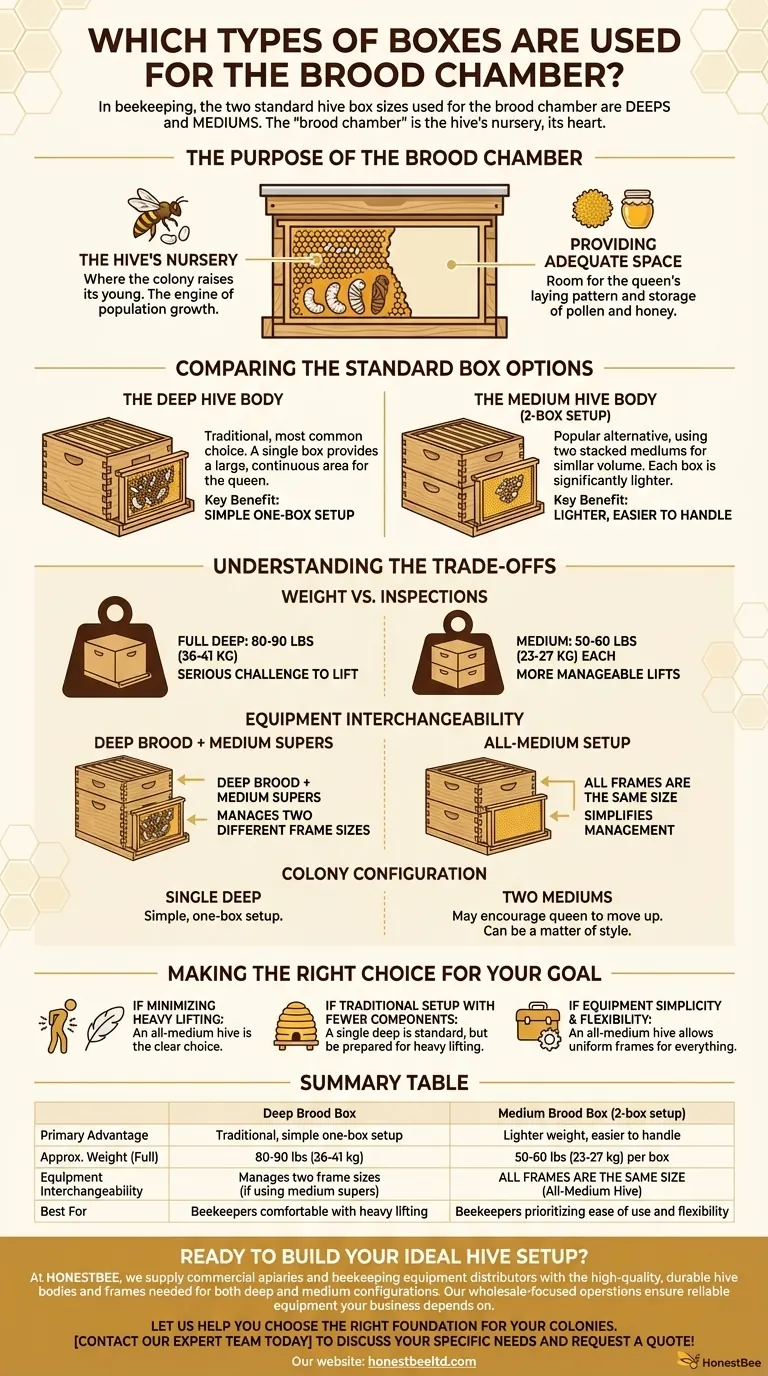In beekeeping, the two standard hive box sizes used for the brood chamber are deeps and mediums. The "brood chamber" itself isn't a type of box, but a term describing its function as the hive's nursery. The choice between a deep or medium box is a foundational decision that directly impacts how you will manage your hive, primarily concerning weight and equipment interchangeability.
The core decision is not about which box is "correct," but about balancing the need for adequate brood space against the physical reality of lifting heavy equipment. Your choice should align with your physical ability and desired management style.

The Purpose of the Brood Chamber
To choose the right equipment, you must first understand the function it serves. The brood chamber is the heart of the colony.
The Hive's Nursery
A brood box, or brood chamber, is where the queen lays her eggs and the colony raises its young. It contains the eggs, larvae, and pupae that constitute the "brood." This area is the engine of the hive's population growth.
Providing Adequate Space
The physical box must provide enough uninterrupted space for the queen to establish a healthy laying pattern. It also needs room for the worker bees to store the pollen and honey required to feed the developing brood.
Comparing the Standard Box Options
Your choice comes down to two sizes within the common Langstroth hive system. The dimensions refer to the height of the box.
The Deep Hive Body
The deep box is the traditional, and most common, choice for a brood chamber. A single deep box provides a large, continuous area for the queen to lay eggs.
This configuration is simple, as the entire brood nest is often contained within one piece of equipment, making initial assessments straightforward.
The Medium Hive Body
A popular alternative is to use two stacked medium boxes to form the brood chamber. This configuration provides a similar total volume to a single deep.
The primary advantage is that each individual box is significantly lighter and easier to handle than a single, fully-loaded deep box.
Understanding the Trade-offs
Neither option is universally superior; each comes with clear advantages and disadvantages that you must weigh for your specific situation.
Weight vs. Inspections
A full deep brood box can weigh 80-90 pounds (36-41 kg), making it a serious challenge to lift.
Two medium boxes, by contrast, might weigh 50-60 pounds (23-27 kg) each. While you have to lift two boxes to inspect the full brood nest, each lift is far more manageable.
Equipment Interchangeability
Using an "all-medium" setup, where both your brood boxes and honey supers are mediums, creates a major advantage: all your frames are the same size. This simplifies management immensely, as you can easily move frames of honey, pollen, or brood between any box in the hive.
If you use a deep for the brood chamber and mediums for honey, you will constantly be managing two different frame sizes.
Colony Configuration
A single deep brood box offers a simple, one-box setup. However, some beekeepers find that a two-box medium configuration encourages the queen to move up more readily as the colony expands. This can be a matter of personal observation and management style.
Making the Right Choice for Your Goal
Select your brood chamber equipment based on your physical comfort and long-term management strategy.
- If your primary focus is minimizing heavy lifting: An all-medium hive, using two medium boxes for your brood chamber, is the clear choice.
- If your primary focus is a traditional setup with fewer components: A single deep box is the standard, but you must be prepared to lift a very heavy box.
- If your primary focus is equipment simplicity and flexibility: An all-medium hive allows you to use the same size boxes and frames for everything, which is a powerful advantage.
Ultimately, the best hive is one you can manage safely and effectively for years to come.
Summary Table:
| Feature | Deep Brood Box | Medium Brood Box (2-box setup) |
|---|---|---|
| Primary Advantage | Traditional, simple one-box setup | Lighter weight, easier to handle |
| Approx. Weight (Full) | 80-90 lbs (36-41 kg) | 50-60 lbs (23-27 kg) per box |
| Equipment Interchangeability | Manages two frame sizes (if using medium supers) | All frames are the same size (All-Medium Hive) |
| Best For | Beekeepers comfortable with heavy lifting | Beekeepers prioritizing ease of use and flexibility |
Ready to build your ideal hive setup?
At HONESTBEE, we supply commercial apiaries and beekeeping equipment distributors with the high-quality, durable hive bodies and frames needed for both deep and medium configurations. Our wholesale-focused operations ensure you get the reliable equipment your business depends on.
Let us help you choose the right foundation for your colonies. Contact our expert team today to discuss your specific needs and request a quote!
Visual Guide

Related Products
- HONESTBEE Entrance Bee Feeder Professional Hive Nutrition Solution for Beekeeping
- Boardman Entrance Bee Feeder Durable Galvanized Steel and Wood Construction for Beekeeping
- Wholesales Dadant Size Wooden Bee Hives for Beekeeping
- Professional Hive Front Entrance Bee Feeder
- Professional Drop-Style Hive Handles for Beekeeping
People Also Ask
- How does the entrance feeder method work? A Guide to Simple But Risky Hive Feeding
- How is the mesh ladder and barrier installed in the feeder box? A Step-by-Step Guide to Prevent Bee Drowning
- What is a common problem with hive front feeders? Avoid Robbing Frenzies and Protect Your Hives
- How to make an entrance feeder for bees? A DIY Guide for Safe & Effective Feeding
- What are the common types of honey bee feeders? Choose the Right Feeder for Your Hive



















